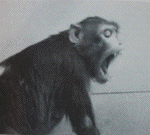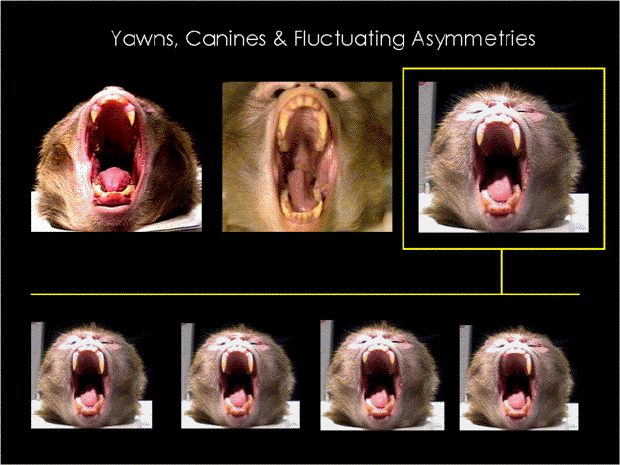For example, in a recent experinient by Dr.
W. D. Joslyn, testosterone was injected three
times weekly for 8 months into three normal
female monkeys, beginning at approximately 5
months of age and ending at 13 rnonths of age.
Studies of the behavior of these animals were
made beginning with the first injections, of
testosterone propionate, and continuing
throughout the final month of testosterone
propionate treatment, and for several months
after termination of testosterone treatment.
These females became hyperaggressive and almost
all their aggressive attacks were directed
against the male members of their peer
groups. In addition, there were marked and
significant increases in yawning behavior, which
is ordinarily related to the display of social
dominance by males. These behavioral changes
induced by testosterone in young females could
be considered a kind of masculinization, but it
is essential to point ont that this
masculinizing influence did not extend to other
kinds of behaviors which are ordinarily
sex-related.
The behavior of young rhesus monkeys in
social groups is markedly sexually dimorphic in
a number of respects. For example, young male
monkeys display sham threat, rough and tumble
play, chasing play and mounting behavior much
more frequently than do females in the same
groups. Similarly, young males initiate play
signifieantly more often than do females.
However, none of these dimorphic behaviors were
influenced by testosterone injected for 9 months
into the juvenile female monkeys studied by Dr
Joslyn. Their averages for frequency of
performance of these activities during the last
month of injection are seen in Table, and their
deviations from the standards set by normal
control females studied over many years are not
large enough to exceed chance expectancy.
The limited masculinization achieved with
these postnatal injections of testosterone
propionate for a long period of time contrasts
markedly with the changes induced in the same
patterns of behavior when genetic female monkeys
are exposed to androgens prior to birth and
rendered pseudohermaphroditic. The patterns of
sham threat, rough and tumble play, play
initiation, chasing play, and mounting behavior
shown by such pseudohermaphroditic females
differ significantly from those of normal
control females and illustrate the broad scope
of the masculinization achieved with prenatal
androgenic exposure. Longitudinal and
developmental changes in all of these social
behaviors are highly similar. For illustrative
purposes, changes in the frequency of Play
Initiation with age for normal males, normal
females, and pseudoherinaphrodites are shown in
Fig. 9.
The limited effects that androgens have on
the behavior of normal females in adulthood can
be ascertained from the following set of
studies. The first of these studies shows that
the behavior of adult rhesus males differs
markedly from that of females. When male and
female subjects are paired for testîng at
frequent intervals throughout the menstrual
cycle of the female, behaviors bearing no
obvious function in reproduction or sexuality,
as well as those forming a constant part of the
sexual repertoire, differ between the sexes.
Data on the frequency of two sexually dimorphic
behaviors, "yawning" and mounting, were
obtained by Stephen Eisele in a study of seven
pairs of rhesus. In this study the pairs were
tested for 12 minutes or until the male
ejaculated, if ejaculation occurred sooner than
12 minutes. Under these conditions, as shown in
Table IV, the fenmales never yawned or
mounted, regardless of the stage of the cycle
when the tests were given.
Males, in contrast, displayed both behaviors
with reasonable consistency, and there was a
tendency for the frequency of performance to the
higher when tests were given on the female's
follicular days than when the female partner was
in the luteal phase of her cycle.
In part, the dimorphisin observed in Eiscle's
study of heterosexual pairs can be attributed to
the insufficiency of endogenous androgens in the
female compared with the male, and in part it is
due to the psychological influence of the
partner. When females are tested with another
female rather than with a male, a higher
frequency of yawning and mounting
typically occurs. In short, in the pair-testing
situation, the probability of performance of
yawning and mounting is increased by the
use of a female as partner regardless of whether
the performer is male or female.
A study carried out in our laboratory in
collaboration with CH Phoenix showed that even
when this psychological factor was taken into
account, the behavior of adult females injected
with testosterone propionate was only partially
masculinized. Of some 28 beavioral
characteristics recorded during standardized 10
minute tests of females, tested with female
partners, only one behavior, which we call and
which is normally characteristic of the adult
inale tested under similar circumstances, was
influenced. The effects of testosteron
propionate administered for 4 weeks and in two
different doses on both yawning, and
mounting behavior in adult females are
summarized inTable V.
The reader can observe in Table V that in
female-female pair tests both yawning and
mounting are displayed prior to the injection of
testosterone propionate. This difference from
the results obtained for females when adult
males were used as partners. When testosterone
propionate was injected, the frequency of
mounting did not increase significantly and
remained substantially below that for normal
males. In contrast, the frequency of
yawning behavior not only incresed
significantly during injections of testosterone
propionate, but it was substantially higher than
that for normal males tested with females. Agan,
as in the previous example with juvenile females
discussed in an earlier section of this article,
testosterone propionate in the adult female,
although it induced a 20-fold increase in
yawning behavior, failed to induce any
significant increases in homosexual mounting
activity. We interpret these results to mean
that testosterone has little or no ability to
"masculinize"the sexual behavior of normal
female rhesus even though some influence of this
hormone on social behaviors can be measured.
Althoughthe hamster is more sluggish in its
response than other rodents, the results of
similar experiments in females from lower
mammalian species contrst markedly with our
results on primates. In the former species
mounting behavior is regulary induced or
augmented with injections of testosterone.
[...]
The results of our experiments with primates
show that the effects of testosterone given
before birth are not greatly different from
those of similar treatments in nonprimate
mammals. However, such a conclusion seems
premature, and the manner in which the hormones
act to accomplish masculinization may be in
fact, quite different in these two mammalian
groups. The influence of experience on the
development of sexual and social behaviors is
small in lower mammals compared with higher
primates. For the former, it may be possible to
postulate, as Dorner (1970) has done, that
the androgens present early in development
act upon separate neural circuits for the
expression of masculine and feminine components
of sexual behavior. This seems all the more
plausible since very small brain lesions and
very discrete placements of steroïd
hormones in the brains of castrate animals have
been shown to abolish or restore, respectively,
full sexual behaviors in a variety of nonprimate
animals. When one considers, however, the
important contribution which experience may make
to the expression of sexual and social
beliaviors in primates it does not seem
reasonable to postulate a simple manner or a
diserete locus of androgen action. If in higher
primates a large part of sexual and sex-related
behavior is experientially determined, then it
seems reasonable to infer that androgens present
before birth ut upon the neural circuits
mediating the effects of experience as well as
upon the neural circuits for masculine and
feminine behavior. Our experiences with the
rhesus monkey suggest that one might turn one's
attentions instead to the effects of androgen on
the development of neural systems underlying
drive and reward, i.e., those systenm which
permit experience to exert its ultimate
influences on behavior.





